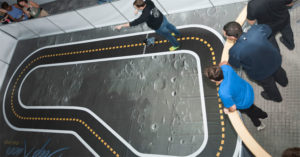In DeepRacer Challenge, Algorithms Provide Path Across the 'Moon'
In DeepRacer Challenge, Algorithms Provide Path Across the ‘Moon’
Elizabeth Goldbaum, August 2019, elizabeth.f.goldbaum@nasa.gov

Participants look on as an autonomous car makes its way around a track during the NASA DeepRacer Challenge. (Photo credit: NASA/Goddard/Debora McCallum)
On a vinyl race car track resembling the surface of the Moon, summer interns took turns racing a toaster-sized autonomous car. Their goal? To see whose algorithm could propel the car the fastest while staying on the track.
The shoe-shaped track for the NASA DeepRacer Challenge – which took place on Aug. 8 in the Building 28 atrium – required participants to come up with an algorithm that would steer the vehicle as it approached both left and right turns, as well as straightaways.
“Nice, that’s a good turn!” said a representative from Amazon AWS, which developed the DeepRacer autonomous cars, as intern Akshay Anil watched the race car run on his algorithmic model, dubbed “Lil’Carty A.”
The event’s ultimate purpose was to provide a fun, engaging way to demonstrate how machine learning works. Prior to the big race, interns attended a workshop with representatives from Amazon AWS to learn how to program a model and guide the car as it attempts to complete laps around a racecourse.
Models relied on reinforcement learning, meaning they would be rewarded when they followed the track and penalized when they strayed off course. These same principles can help in real scientific endeavors, like guiding a future planetary rover as it attempts to navigate new terrains.
“I hope that this project will spark more interest in reinforcement learning as a means to produce cost-effective methods for automating tasks that need to be done,” Anil said. He hopes to become a software engineer when he graduates with a computer science degree from the University of Maryland, College Park.
Fellow competitor and intern Emma Zimmerman is also studying computer science at Seattle Pacific University. “I’m in a club for women in engineering and computer science, and I would absolutely love to get them involved in things like this,” she said. She named her model “Tracy Chapman” in reference to the singer’s song “Fast Car.” “One of the most valuable parts of my experience with the race is being able to bring my knowledge back to others,” Zimmerman said.